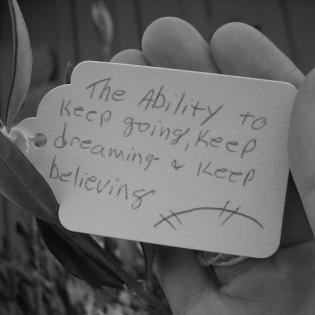Deliver Gratitude Day (K-5)
This lesson focuses on the meaning and benefits of gratitude. A book about a gratitude jar challenges us to brainstorm things they are grateful for right now. For their service project, participants 'deliver gratitude' to others in the school community by saying "thank you" and observing the reactions of the person they thanked, as well as how they feel. They will keep a gratitude jar and add to it each day; they may look at their entries on tough days. They may add to others' jars with kind words.
Photo Credit: Gratitude Tag by Eugene Kim is licensed under CC by 4.0
The learners will:
- define gratitude and name things they are grateful for.
- express gratitude in different ways and for big and small things.
- observe how they feel about the expressions of gratitude.
read-aloud copy or video of the book My Gratitude Jar by Kristin Wiens
Collect jar-like containers for each child where they will collect expressions of gratitude over time.
Children make a gratitude jar to bring home for the family to fill with things they are grateful for.
Read through the expressions of gratitude and discuss how it makes you feel.
Instructions
Anticipatory Set
Brainstorm, "What are some things we say thank you for?"
Define gratitude as a state of being thankful. Tell them to close their eyes and meditate for 15 seconds on a time they felt thankful, or gratitude. After 15 seconds, ask them what it feels like when they feel gratitude. They may say, "happy, peaceful, love, or friendly."
Say that scientists have shown that feeling gratitude makes us happy because it reminds us that there are good things in the world. Say, "We are going to use this information about gratitude to make someone else happy."
Read aloud the book The Gratitude Jar by Kristin Wiens. Before reading (or watching on YouTube), tell listeners to listen for the two things the jar is useful for. After watching, ask them to recall the two things. Call attention to the note the teacher added to the jar and how it made the child feel.
Give each child a container they will use as a gratitude jar. They may use classroom scraps and art materials to decorate their jar. Give them each a label (handout below) to write their name on. Attach the label to the container with shipping tape.
While they work, talk about how they will use the jar to express gratitude each day. It can be for something big or something small. Give them time each day to meditate on something to be thankful for, something good in their world. Provide strips of paper for their thoughts (words or drawings) to put in the gratitude jar.
As an experiment, challenge each child to say thank you genuinely to others as many times as possible in a given time frame (e.g., three hours). After that time, come back together and talk about how people react to their gratitude, and how they feel about expressing gratitude.
Talk about how they can spread happiness at school or in their community by teaching others about gratitude. Discuss how they can "teach" gratitude. It may be by thanking people sincerely more often. It may be by making a poster that teaches what they learned about gratitude. Come up with a project together, and follow youth voice.
At the end of a couple weeks, give the participants time to read through the thoughts of gratitude in their jars and reflect on their service. Ask them to write a paragraph about the project -- what they did and the impact of the expressions of gratitude.
